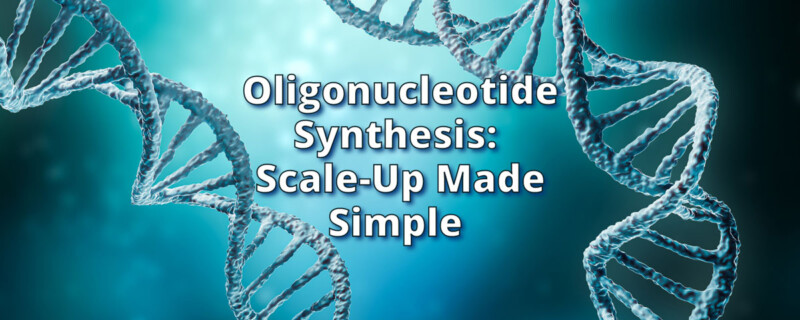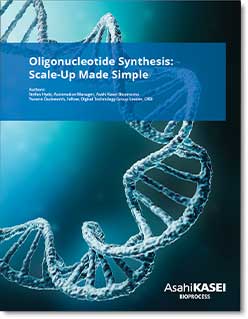
Simplifying Oligonucleotide Synthesis Scale-Up
Oligonucleotide Synthesis: Scale-Up Made Simple
In recent years, the demand for oligonucleotides has surged due to the rapid advancements and clinical success of nucleic acid-based therapies. These treatments use synthetic oligonucleotides to modify gene expression, target specific genetic sequences, and modulate cellular processes, potentially treating diseases such as genetic disorders, cancer, infectious diseases, and Alzheimer’s. Implementing oligonucleotides at scale could greatly improve global health.
Oligonucleotides are short DNA or RNA molecules, typically around 20 nucleotides long, synthesized using the solid-supported phosphoramidite method. This technique, standard since the 1970s, is automated by oligosynthesizer devices that perform sequential chemical reactions to covalently link nucleotide building blocks. These devices offer precise control and monitoring during synthesis and are compatible with various nucleotide chemistries and purification techniques.
However, oligonucleotide synthesis is complex and presents scalability challenges. Translating processes from benchtop synthesizers to larger-scale platforms is difficult, as scaling up is not straightforward. The physical scaling of synthesizer systems requires careful consideration of critical parameters to ensure a smooth transition. Selecting the right synthesizer and automation software can simplify this process, aiding method development and optimization whether scaling within the same equipment range or switching to different systems.
Asahi Kasei Bioprocess (AKB) has published a white paper titled “Oligonucleotide Synthesis: Scale-Up Made Simple.” This publication provides best practices and process steps from bioprocessing experts who detail oligonucleotide synthesis scale up, including challenges and solutions.
The white paper begins by describing how scaling up unit operations is not a straightforward copy-and-paste process. It requires a comprehensive assessment of critical process parameters (CPPs) and how they are affected during scaling. Parameters like loop recirculation volume and column diameters may not scale linearly across different-sized devices, presenting additional challenges. For example, scaling a process using Controlled Pore Glass (CPG) solid support requires careful consideration of factors like column diameter and bed height.
Operators must decide between volumetric “scale out” or “scale up” approaches to optimize the process. For instance, scaling from 100 µmol to 300 µmol requires a larger column and adjusting parameters like bed height and nominal scale. Intuitive tools that simulate process optimization can facilitate rapid process development and method transfer during scale-up.
The white paper goes on to discuss the increasing need for plug-and-play systems in the pharmaceutical industry, particularly for oligonucleotide synthesis. These systems are designed to integrate easily with existing IT and OT infrastructures, promoting connectivity and interoperability. Familiar, user-friendly, web-based interfaces are more likely to be adopted by organizations, especially in regulated environments where compliance with 21 CFR Part 11 is crucial for maintaining data integrity and traceability.
Expert authors, recommend that organizations should evaluate systems for usability and efficiency to ensure smooth scale-up operations. Ideal systems should offer intuitive tools, customizable templates, and remote-access capabilities for easy process development. The Asahi Kasei Bioprocess (AKB) OCELOT™ System Control software is an example of such functionality. This advanced automation and control platform supports AKB’s range of oligosynthesizers, enhancing process control and intuitive scaling. The OCELOT system is 21 CFR Part 11 compliant and operates on a web-based Windows 10 Enterprise interface, facilitating seamless connectivity to existing plant-wide control systems.
The OCELOT software aids process development with intuitive recipe and method configuration capabilities, including a Simulation Mode and context-based recipe editing. Its unique Control Parameters approach allows for seamless scaling by automatically adjusting parameters based on process-specific critical process parameters (CPPs).
Partnering with experienced providers like AKB can make the transition to larger-scale oligonucleotide synthesis platforms more manageable. AKB offers a suite of columns, synthesizers, and purification systems powered by the OCELOT System Control, along with comprehensive technical support. This support helps organizations maximize the potential of their oligonucleotide therapies by guiding them through the scale-up process and addressing any challenges with expert solutions. As the demand for oligonucleotide drugs increases, innovative plug-and-play technologies and dedicated customer support from AKB are well-positioned to meet the evolving needs of the industry.
To read the entire white paper, please see Oligonucleotide Synthesis: Scale-Up Made Simple
